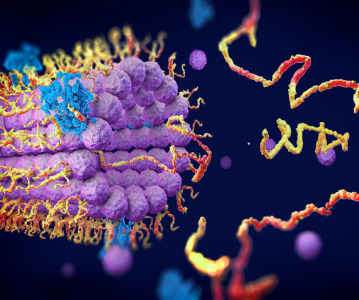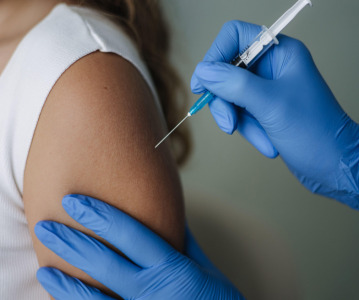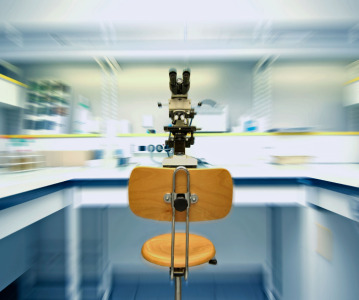Gene Therapy: A Complex and Evolving Manufacturing Challenge

Gene therapies have the potential to revolutionize treatment options for patients suffering from cancer, cystic fibrosis, heart disease, diabetes, Parkinson's, AIDS and Alzheimer's by replacing, inactivating or introducing genes into cells —either inside the body (in vivo) or outside of the body (ex vivo) [1].
Despite the huge therapeutic potential, these complex solutions bring equally complex manufacturing challenges, ranging from smaller batch sizes to scarcity of viral vectors.
Gene therapies could revolutionize the treatment of inherited diseases but firms hoping to follow Luxturna to market must remember that, from a manufacturing perspective, the field is still in its infancy. When the US FDA approved Luxturna for the treatment of the rare, inherited vision loss disease Leber's congenital amaurosis (LCA) in December, it was the gene therapy’s $425,000-a-vial price tag that attracted most attention [2].
The focus on price is understandable, particularly given the current debate about US healthcare costs [3], but it has meant the technical achievement of bringing Luxturna to market has been somewhat overlooked. Drug approvals are mainly based on safety and efficacy data, but the FDA also takes manufacture into consideration.
To win approval, Luxturna developer – Spark Therapeutics – had to prove it makes the drug in a reliable and compliant way, which an achievement is given the complex biological system-based manufacturing steps involved [4].
Making gene therapies
A gene therapy is defined as a medicine that treats disease by either introducing genetic material into a cell or modifying the code or expression of an existing gene. Broadly speaking, there are two types. Those like Luxturna that are delivered using a modified virus and those that are not, like the transposon-based drugs being developed by Poseida Therapeutics.
For virus-based therapies, delivery either takes place outside the body - like Novartis’ Kymriah where a virus inserts genes for a cancer targeting receptor into harvested immune cells before re-implantation – or inside, like Luxturna.
There are some common phases involved in making a gene therapy - starting material production; cell line development; manufacture in culture; and harvesting and purification – however, production methods vary per product. Likewise, there is considerable variation in the manufacturing and processing technologies used to make gene therapies.
Francesca Vitelli, process development head at Lonza’s new gene therapy facility in Houston, Texas [5] told us, “The field is not particularly consolidated on which virus is the best. We work with AAV, lenti, adeno and oncolytic viruses amongst others. “The methods to make these virus also vary considerably with different cell lines, different helper viruses, different culture methods and different transfection methods for virus production.
"Downstream processing steps are relatively more consolidated, with post-harvest steps comprising a combination of concentration and buffer exchange steps, resin or membrane or monolith chromatography- ideally a capture and a polishing step- and then formulation” she added.
This was echoed by Keith Thompson, CEO of Cell and Gene Therapy Catapult (CGTC) which a UK-based centre of excellence that fosters innovation in biopharmaceutical manufacturing.“Traditional pharmaceutical or biologic products have tended towards a common manufacturing process or platform, which can be used to manufacture a variety of different products to treat a broad number of clinical indications.
“The huge variety observed in cell and gene therapy products translates to the plethora of manufacturing processes trialled, with a diverse range of technologies and scales being explored and developed. This is expected to put a significant strain on current GMP manufacturing infrastructure as not all facilities can accommodate the range of processes” Thompson said.
Technology improvements
Despite the wide range of manufacturing methods and technologies being employed by industry, there are some common production bottlenecks according to Vitelli, who cited viral yields as an example. “Current production steps where the actual virus is assembled or amplified need to be improved to maximize efficient use of cell biomass,” she said, adding that “overall process efficiency throughout all processing steps can be increased for all virus types.”
Vitelli said, “This is similar to the early days in the monoclonal antibody world where 30 years ago, batch quantities were measured in mg/L while now we often see upwards of 5g/L.”
Gene therapy market
Whether Luxturna kick starts the gene therapy market remains to be seen. Issues like immunogenicity and tropism may be more of a problem for drugs not delivered into the eye.
Nevertheless there are positive signs. Vitelli told us, “Gene therapy is in its infancy … but there is a fundamental shift in production philosophy as more personalized medicine understanding spreads.
“Instead of making large quantities of the same molecule in campaign mode, batches will be tailored to more “bespoke molecules” and likely in much smaller scale – even to individual patient scale. The challenge is to be able to scale out to customized smaller quantities rather than scale up, but without negatively impacting COGs.”
Keep pace with developments in the Gene Therapy sector
Each year the CPHI brand unites more than 100,000 pharmaceutical professionals through exhibitions, conferences and online communities. If you're looking to meet the leading manufacturers and developers of gene therapies, learn the latest developments through quality conferences and access unparalleled networking opportunities we offer a portfolio of global exhibitions in all major pharma markets throughout the year - take a look at our event calendar for more information.
References
[1] https://www.asgct.org/education/different-approaches
[2] https://icer-review.org/announcements/voretigene-evidence-report/
[4] https://www.fda.gov/downloads/BiologicsBloodVaccines/CellularGeneTherapyProducts/ApprovedProducts/UCM592766.pdf
Related News
-
News CPHI Podcast Series: The power of proteins in antibody drug development
In the latest episode of the CPHI Podcast Series, Lucy Chard is joined by Thomas Cornell from Abzena to discuss protein engineering for drug design and development. -
News Amgen sues Samsung biologics unit over biosimilar for bone disease
Samsung Bioepis, the biologics unit of Samsung, has been issued a lawsuit brought forth by Amgen over proposed biosimilars of Amgen’s bone drugs Prolia and Xgeva. -
News CPHI Podcast Series: Why we need to consider women in clinical trials
The latest episode of the CPHI Podcast Series with Lucy Chard covers women's health, specifically women's representation in clinical trials, the associated bias, and the impacts on health for this population. -
News US FDA does not approve MDMA therapy for PTSD, requests more data
The MDMA-based therapeutic developed by Lykos Therapeutics, a California-based Public Benefit Corporation (PBC), has been reviewed and unapproved by the US FDA. The regulator has requested additional phase III trial data for further safety and efficacy... -
News Novartis and Viatris latest facing lawsuit over HeLa cell misuse
Global pharmaceutical companies Novartis and Viatris are the latest hit with a lawsuit claim pertaining to alleged misuse of the ‘HeLa’ cell line from the estate of woman whose cancerous tissue cells were taken without consent. -
News Sanofi invests billions into Frankfurt insulin production site
French pharmaceutical company Sanofi have announced an investment of EUR1.3 billion at their existing BioCampus site in Frankfurt am Main for the expansion of insulin production. -
News Novel oral Type 1 diabetes drug gains US FDA IND designation
A University of Alabama at Birmingham startup has gained FDA clearance for Investigational New Drug clinical trials for an oral Type 1 diabetes drug, a milestone for diabetes treatment. -
News A Day in the Life of a Vice President in R&D & Engineering
In the Day in the Life of Series, we've already had the chance to get to know a range of people in various roles in the pharma industry. In the latest interview we get a glimpse into the R&D side of things from Jennifer Sorrells, Vice Presiden...
Position your company at the heart of the global Pharma industry with a CPHI Online membership
-
Your products and solutions visible to thousands of visitors within the largest Pharma marketplace
-
Generate high-quality, engaged leads for your business, all year round
-
Promote your business as the industry’s thought-leader by hosting your reports, brochures and videos within your profile
-
Your company’s profile boosted at all participating CPHI events
-
An easy-to-use platform with a detailed dashboard showing your leads and performance

.png)

.png)
.png)
.png)
.png)
